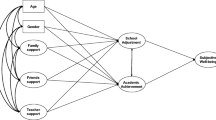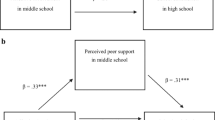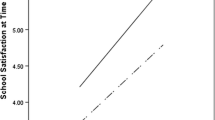Abstract
One of the most fundamental factors related to psychological well being across the lifespan is whether a person perceives social support from important others in his or her life. The current study explored changes in and relationships among perceived social support (SS) and socioemotional adjustment (SEA) across the 1-year transition from elementary to junior high school. Two cohorts of students (N = 140) participated in the current study that took place across a 3-year time span. Analyses of the transition data for boys and girls together reveal declines in perceived total support and teacher support as well as an increase in self-reported school problems. When considering the sexes separately, girls’ perceived total support, close friend support and school support declined while boy’s self-reported school problems increased across the transition. Although social support did not emerge as a mediator or predictor for any of the socioemotional variables in the current study, results reveal that, in general, perceived social support and socioemotional functioning at the end of the last year of elementary school predicts perceived social support and socioemotional functioning at the end of the first year of junior high school. Study limitations and implications for research and practice are discussed.
Similar content being viewed by others
Notes
We do not show the figure in this article because of the complexity of the figure. It was not possible to read all regression weights on the figure clearly. We report all unstandardized regression weights and standard errors in Table 5.
References
Akos, P. (2002). Student perceptions of the transition from elementary to middle school. Professional School Counseling, 5, 339–345.
Anderman, E. M., & Midgley, C. (1997). Changes in achievement goal orientations, perceived academic competence, and grades across the transition to middle-level schools. Contemporary Educational Psychology, 22, 269–298.
Arbuckle, J. L. (2007). Amos (Version 16.0) [Computer software]. Chicago: SPSS.
Berk, L. E. (2003). Development through the lifespan (3rd ed.). New York: Allyn & Bacon.
Cantin, S., & Boivin, M. (2004). Change and stability in children’s social network and self-perceptions during transition from elementary to junior high school. International Journal of Behavioral Development, 28(6), 561–570.
Cohen, S., & Wills, T. A. (1985). Stress, social support, and the buffering hypothesis. Psychological Bulletin, 98, 310–357.
Colarossi, L. G., & Eccles, J. S. (2003). Differential effects of support providers on adolescents’ mental health. Social Work Research, 27(1), 19–30.
Cornwell, B. (2003). The dynamic properties of social support: Decay, growth, and staticity, and their effects on adolescent depression. Social Forces, 81(3), 953–978.
Demaray, M. K., & Malecki, C. K. (2002). The relationship between perceived social support and maladjustment for students at risk. Psychology in the Schools, 39, 305–316.
Demaray, M. K., Malecki, C. K., Davidson, L. M., Hodgson, K. K., & Rebus, P. J. (2005). The relationship between social support and student adjustment: A longitudinal analysis. Psychology in the Schools, 42(7), 691–706.
DuBois, D. L., Burk-Braxton, C., Swenson, L. P., Tevendale, H. D., Lockerd, E. M., & Moran, B. L. (2002). Getting by with a little help from self and others: Self-esteem and social support as resources during early adolescence. Developmental Psychology, 38(5), 822–839.
Eccles, J. S. (2004). Schools, academic motivation, and stage-environment fit. In R. M. Lerner & L. Steinburg (Eds.), Handbook of adolescent psychology (2nd ed., pp. 125–153). Hoboken, NJ: Wiley.
Eccles, J. S., Midgley, C., Wigfield, A., Buchanan, C. M., Reuman, D., Flanagan, C., et al. (1993). Development during adolescence: The impact of stage-environment fit on young adolescents’ experiences in schools and in families. American Psychologist, 48, 90–101.
Garnefski, N., & Diekstra, R. F. W. (1996). Perceived social support from family, school, and peers: Relationship with emotional and behavioral problems in adolescents. Journal of the American Academy of Child and Adolescent Psychiatry, 35(12), 1657–1664.
Gutman, L., & Midgley, C. (2000). The role of protective factors in supporting the academic achievement of poor African American students during the Junior high school transition. Journal of Youth and Adolescence, 29, 223–248.
Harter, S. (1985). Manual for the Social Support Scale for Children. Denver, CO: Author.
Helsen, M., Vollebergh, W., & Meeus, W. (2000). Social support from parents and friends and emotional problems in adolescence. Journal of Youth and Adolescence, 29(3), 319–335.
Indiana Department of Education. (2005). Corporation snapshot, Richland-Bean Blossom CSC #5705. Retrieved June 29, 2005, from http://www.doe.state.in.us/asap/statesnap3.html.
Levitt, M. J., Levitt, J., Bustos, G. L., Crooks, N. A., Santos, J. D., Telan, P., et al. (2005). Patterns of social support in the Junior high childhood to early adolescent transition: Implications for adjustment. Social Development, 14(3), 398–420.
Lewinsohn, P. M., Hops, H., Roberts, R. E., Seeley, J. R., & Andrews, J. A. (1993). Adolescent psychopathology: Prevalence and incidence of depression and other DSM-III-R disorders in high school students. Journal of Abnormal Psychology, 102, 133–144.
Malecki, C. K., & Demaray, M. K. (2002). Measuring perceived social support: Development of the child and adolescent social support scale (CASSS). Psychology in the Schools, 39, 1–18.
Malecki, C. K., & Demaray, M. K. (2003). What type of support do they need? Investigating student adjustment as related to emotional, informational, appraisal, and instrumental support. School Psychology Quarterly, 18, 231–252.
Malecki, C. K., Demaray, M. K., & Elliott, S. N. (2000). The Child and Adolescent Social Support Scale. DeKalb, IL: Northern Illinois University.
Paxton, K. C., Robinson, W. L., Shah, S., & Schoeny, M. E. (2004). Psychological distress for African-American males: Exposure to community violence and social support as factors. Child Psychiatry and Human Development, 34(4), 281–295.
Reynolds, C. R., & Kamphaus, R. W. (2004). BASC-2: Behavior assessment system for children (2nd ed.). MN: AGS Publishing, Circle Pines.
Schmitt, V. L. (2004). The relationship between Junior high level grade span configuration, professional development, and student achievement. Research in Junior High Level Education, 27(1), 1–17. Retrieved October 6, 2005, from http://nmsa.org/research/rmle/spring04/article_1.html.
Tabachnick, B. G., & Fidell, L. S. (2007). Using multivariate statistics (5th ed.). New York: Allyn & Bacon.
Turner, H. A., Hayes, R. B., & Coates, T. J. (1993). Determinants of social support among gay men: The context of AIDS. Journal of Health and Social Behavior, 34(1), 37–53.
Weigel, D. J., Devereux, P., Leigh, G. K., & Ballard-Reisch, D. (1998). A longitudinal study of adolescents’ perceptions of support and stress: Stability and change. Journal of Adolescent Research, 13, 158–177.
Wenz-Gross, M., Siperstein, G. N., Untch, A. S., & Widaman, K. F. (1997). Stress, social support, and adjustment of adolescents in Junior high school. Journal of Early Adolescence, 17(2), 129–151.
Wigfield, A., & Eccles, J. S. (1994). Children’s competence beliefs, achievement values, and general self-esteem: Change across elementary and junior high school. Journal of Early Adolescence, 14(2), 107–138.
Acknowledgments
The research and preparation of this article was supported by a Proffitt Faculty Fellowship (PFF) given to the first author from the School of Education at Indiana University Bloomington, Indiana. We wish to thank Debbie Ferree, Larry Sparks and the teachers and students of Edgewood Intermediate School and Edgewood Junior High School for their enthusiastic involvement in this project.
Author information
Authors and Affiliations
Corresponding author
Rights and permissions
About this article
Cite this article
Martínez, R.S., Aricak, O.T., Graves, M.N. et al. Changes in Perceived Social Support and Socioemotional Adjustment Across the Elementary to Junior High School Transition. J Youth Adolescence 40, 519–530 (2011). https://doi.org/10.1007/s10964-010-9572-z
Received:
Accepted:
Published:
Issue Date:
DOI: https://doi.org/10.1007/s10964-010-9572-z




